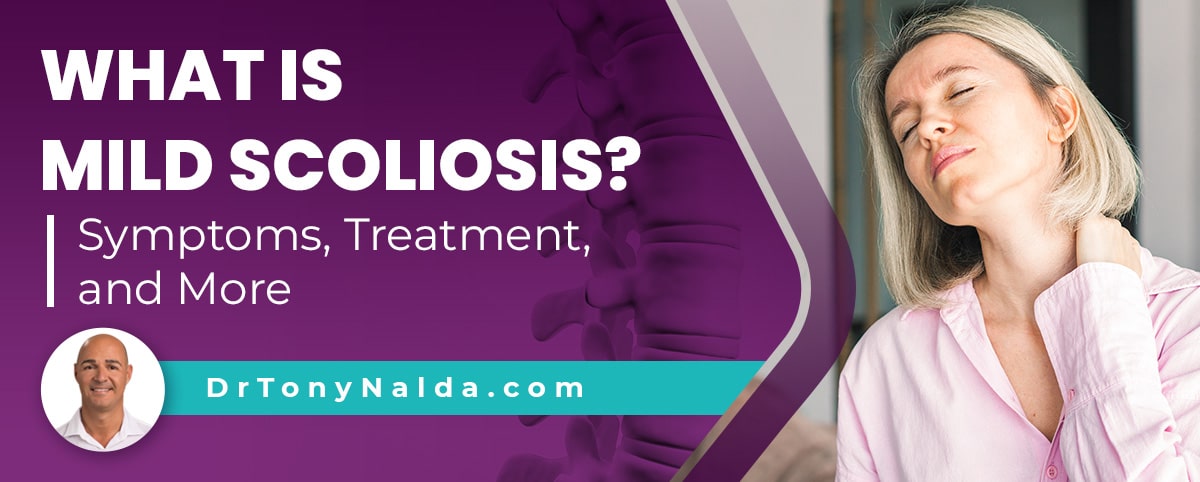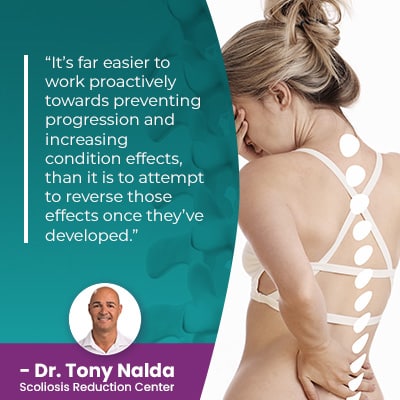What Is Mild Scoliosis? Symptoms,Treatment, and More

No two cases of scoliosis are the same; not only are there different severity levels, there are also different types of scoliosis, it can affect all ages, and can develop in any of the spine’s main sections. As a progressive condition, virtually all cases of scoliosis are guaranteed to get worse at some point, so mild scoliosis won’t stay that way without the help of proactive treatment.
Scoliosis is a complex 3-dimensional spinal condition that involves the development of an unnatural sideways spinal curve. Scoliosis ranges widely in severity from mild to moderate and severe to very severe, and mild scoliosis is the first stop on the condition’s progressive line.
Before getting to the specific symptoms and treatment needs of mild scoliosis, let’s start with how it’s diagnosed.
Table of Contents
Diagnosing Mild Scoliosis
The spine’s healthy curves are key to maintaining its optimal health, strength, and function, and as there are a number of spinal conditions that cause a loss of the spine’s natural and healthy curves, let’s talk about what sets scoliosis apart.
In order to reach a diagnosis of mild scoliosis, certain parameters have to be met; in addition to the unnatural spinal curve bending to the side, it also has to have a rotational component to be considered a true scoliosis.
So a scoliotic spine both bends and twists unnaturally, making it a complex 3-dimensional spinal condition.
A scoliotic curve has to also be of a minimum size: Cobb angle measurement of at least 10 degrees.
A patient’s Cobb angle is determined via X-ray and involves drawing lines from the tops and bottoms of the curve’s most-tilted vertebrae, at its apex, and the intersecting lines form an angle that’s expressed in degrees.
The higher a patient’s Cobb angle, the more severe the condition, and this is how mild scoliosis is diagnosed:
- Mild scoliosis: Cobb angle measurement of between 10 and 25 degrees
- Moderate scoliosis: Cobb angle measurement of between 25 and 40 degrees
- Severe scoliosis: Cobb angle measurement of 40+ degrees
- Very-severe scoliosis: Cobb angle measurement of 80+ degrees
Remember, as a progressive condition, a diagnosis of mild scoliosis isn’t indicative of where it will stay; only proactive treatment can work towards counteracting the condition’s progressive nature.
So for someone recently diagnosed with mild scoliosis, what are some expected symptoms?
Mild Scoliosis Symptoms
No two cases of scoliosis are the same, and the reality is that, oftentimes, the symptoms of mild scoliosis are too subtle for people, other than experts trained in what to look for, to notice.
Part of the reason I wrote Scoliosis Hope was to help spread awareness of the condition’s early signs so early detection and intervention can be achieved.
I’d also like to take a minute to explain one of the main differences between scoliosis symptoms in children, versus adults.
As mentioned, even when mild, scoliosis is introducing the body to uneven forces, and in children, the main symptom is postural deviation, and in adults, the condition’s main symptom is pain.
Scoliosis doesn’t become a compressive condition until adulthood, when skeletal maturity has been reached, at which time the spine and its surrounding muscles and nerves are vulnerable to compression.
In children who are still growing, the spine is experiencing a constant lengthening motion, and this counteracts the compressive force of the curve.
While adults can also experience postural deviation as a symptom of scoliosis, pain is the number-one reason adults come to see me for a diagnosis and treatment.
The earliest signs of mild scoliosis in children are often uneven shoulders and hips, but can also include:
- A head that’s uncentered over the body
- Ribs that protrude more on one side than the other
- A prominent lean to one side when standing
- Arms and legs that appear to hang at different lengths
- One hip sitting higher than the other
These types of postural changes occur because the condition’s uneven forces disrupt the body’s overall symmetry, and additional signs of mild scoliosis can include clothing suddenly seeming ill-fitting, and changes to balance, coordination, and gait.
So for adults, some postural deviation and pain are common symptoms of mild scoliosis, and in children, it’s postural changes that disrupt the body’s overall symmetry that are the most-noticeable symptoms.
If left untreated, mild scoliosis can easily progress, so let’s talk about what progression means, why early detection and intervention can be so beneficial, and mild scoliosis treatment options.
Progression and Mild Scoliosis
A big part of treatment is managing progression, so what exactly does that mean?
As scoliosis progresses, the unnatural spinal curve is increasing in size, and as this happens, the spine becomes more rigid, and the condition’s uneven forces are increasing, as are their effects.
As the spine gets more rigid, it’s going to be less responsive to treatment, and in addition, a key facet of treatment involves condition-specific exercises and stretches, and if a patient’s ability to perform these exercises, because of increasing spinal rigidity, is disrupted, that complicates the treatment process further.
While there are never treatment guarantees, there are a number of benefits associated with early detection, but only if a diagnosis is responded to with proactive conservative treatment.
We also know that it’s growth and development that triggers scoliosis to progress, so counteracting that progressive nature is especially important when treating scoliosis in children because they are at risk for rapid-phase progression caused by rapid and unpredictable growth spurts.
 Scoliosis is simpler to treat when it’s mild, before significant progression has occurred making the spine less responsive to treatment, and before the body has had ample time to adjust to the unnatural curve’s presence.
Scoliosis is simpler to treat when it’s mild, before significant progression has occurred making the spine less responsive to treatment, and before the body has had ample time to adjust to the unnatural curve’s presence.
When scoliosis is diagnosed and treated while mild, there are fewer limits to what can be achieved.
Mild Scoliosis Treatment Options
When it comes to choosing the type of treatment to commit too, patients have an important decision to make.
There are two main scoliosis treatment approaches, traditional and conservative, and they offer patients different potential results that affect the spine differently.
Traditional treatment offers a reactive surgical response, while conservative treatment responds proactively with the goal of preventing progression and the need for invasive surgery in the future.
Here at the Scoliosis Reduction Center, I treat cases of mild scoliosis proactively, by starting treatment as close to the time of diagnosis as possible; this is when the condition is likely to be its most responsive, when symptoms are still mild, and condition effects have not increased.
 It’s far easier to work proactively towards preventing progression and increasing condition effects, than it is to attempt to reverse those effects once they’ve developed.
It’s far easier to work proactively towards preventing progression and increasing condition effects, than it is to attempt to reverse those effects once they’ve developed.
I integrate multiple treatment modalities so every treatment plan can be fully customized to address key patient/condition variables, and conditions can be impacted on every level.
Through condition-specific chiropractic care, I can work towards achieving a curvature reduction on a structural level, and once I see structural results, I can start working towards increasing core strength so the spine is optimally supported by its surrounding muscles.
Corrective bracing can help augment corrective results by pushing the spine into a corrective position, and this can be particularly effective on patients whose spines are still growing.
The final phase of treatment is ongoing because as a progressive condition, scoliosis is incurable, so continued effort is needed to sustain treatment results, and this can involve continued chiropractic care and a series of custom-prescribed exercises/stretches to help patients establish a home-rehabilitation program to further stabilize and heal the spine.
Conclusion
The most important thing to understand about mild scoliosis is that this is the best time to start treatment because as a progressive condition, it’s going to get worse over time.
As scoliosis progresses, it gets more complex to treat, so why not start scoliosis treatment as early in its progressive line as possible?
A diagnosis of mild scoliosis means a person has developed an unnatural spinal curve with a Cobb angle measurement of between 10 and 25 degrees.
While not all cases of mild scoliosis will produce noticeable symptoms that can lead to a diagnosis and treatment, knowing the condition’s early signs can help increase the likelihood of early detection and intervention.
There are never treatment guarantees, but as a progressive condition triggered by growth, the best time to start treatment for scoliosis of all severity levels is always now.
Here at the Center, patients who have achieved early detection can benefit from a proactive treatment approach that works towards preventing progression, increasing condition severity, and the need for more invasive treatment in the future.
When scoliosis is treated successfully with conservative treatment, as much of the spine’s natural strength and function as possible is preserved, and this helps patients live their best lives throughout treatment and beyond.
Dr. Tony Nalda
DOCTOR OF CHIROPRACTIC
After receiving an undergraduate degree in psychology and his Doctorate of Chiropractic from Life University, Dr. Nalda settled in Celebration, Florida and proceeded to build one of Central Florida’s most successful chiropractic clinics.
His experience with patients suffering from scoliosis, and the confusion and frustration they faced, led him to seek a specialty in scoliosis care. In 2006 he completed his Intensive Care Certification from CLEAR Institute, a leading scoliosis educational and certification center.
About Dr. Tony Nalda
 Ready to explore scoliosis treatment? Contact Us Now
Ready to explore scoliosis treatment? Contact Us Now





